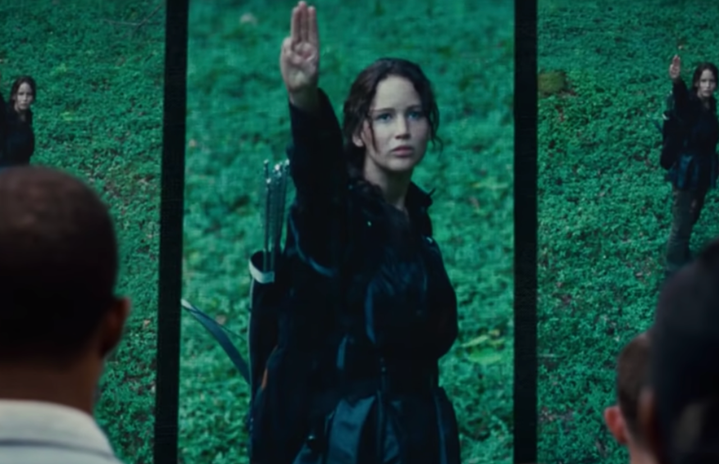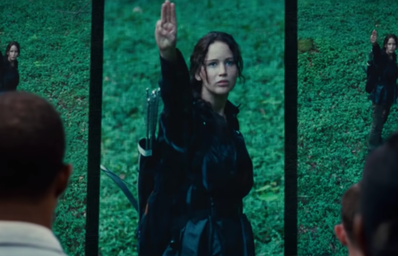I know what you’re probably thinking, “Why should we care about a YA novel?”. Well, I’m here to set the record straight that The Hunger Games trilogy is an extremely important commentary on our modern world. Throughout the hunger games, there is an extremely interesting commentary on modern femininity, race, and whiteness. One prominent example of this can be seen in the first Hunger Games movie, as the tributes first start ‘playing’ the game. WARNING: Spoilers ahead if you haven’t read the books or seen the movies.
Throughout this scene, one thing that really stood out to me was the foreshadowing nature of the highlighted tributes. From this scene, we know who our most prominent contestants are going to be and we also even see some of their death orders. The characters highlighted in this scene are Glimmer, Marvel, Clove, Cato, the boy from District Three, Foxface, Rue, Thresh, Katniss, and Peeta. Glimmer is presented as a flirty girl in a pretty pink dress, and the capital eats her up. They laugh and smile at her charm, but there is sinfulness to Glimmer. She represents the societal idealized female form, which as we know, is villainized throughout the Hunger Games Series. Glimmer demonstrates her embodiment of a villain with the token that she brings from home. Most tributes bring something meaningful to them, but Glimmer brought a ring with a poisoned spike, yet she doesn’t present as cunning to the capital. She is confident and sure of her motives going into the games, she is the opposite of Katniss. She is also the first tribute on the stage in this scene and Katniss’ first kill later in the Hunger Games. The next person we see on screen is Marvel. This is foreshadowing because Marvel kills Rue later on, and is Katniss’ next kill.
Next, we see Clove and Cato, and something I’ve always found interesting is that Clove and Cato are dressed very similar to Katniss and Peeta. Cato and Clove have always paralleled Katniss and Peeta to me. Clove attempts to kill Katniss screams for Cato in her last moments, and is finally killed by Thresh and Cato runs to her side in her last moments. These two represent what you can become under the right conditioning and brainwashing from authoritarian powers. Connecting it to the readings, I believe that one reason Cato and Clove did not win the games is that they both have the power – dynamic of the calculating, somewhat detached effect (they are both the “movie boyfriend”- check out this article! https://www.npr.org/2013/11/25/247146164/what-really-makes-katniss-stand-out-peeta-her-movie-girlfriend) and couldn’t work. After we see Cato and Clove’s interviews, we move on to the boy from district 3, just for a brief second. This is super interesting because it represents his time in the games as well. He helps the careers plant and moves the bombs, but he is disposable to them and once he’s served his purpose and messed up, he’s killed instantly by Cato.
Next, we see Foxface, Peeta’s only kill in these games, presented in blue also seen on the stage briefly. Next, we see Rue on stage who helps to kill Glimmer and is eventually killed by Marvel. It is important to note that Rue is the first black tribute that we see and is presented as an innocent child, but intelligent. Rue is a spark of the revolution because of what happens after her death, therefore the concept of black-ness sparks the revolution is present. Rue makes Katniss more likable and helps her white savior narrative, even if that was not the intention. This is one problematic theme within the literature, the white savior complex. Similarly, Thresh is seen on stage for a moment and is also a black tribute who is seen to be brutish and standoffish. This is a stereotypical portrayal of a black lead but is important to the story. In the end, Thresh’s fate is met by Cato or the Mutts, but either way, ultimately death is from the capital and this is also part of the revolution.
Finally, we meet Katniss and Peeta in this scene and there are a few important things to note here. Katniss specifically is nervous in this scene because she is in front of so many people. Another foreshadowing moment is that Katniss momentarily ‘goes deaf’ and blocks everyone out due to her being scared. This foreshadows her losing her hearing later in the games when she blows up the careers supplies. Another interesting part of Katniss’ interview is that Ceaser Flickerman, a capital man/institution, asks Katniss if her dress is “safe” when she says she has the flames tonight. This puts the emphasis on that the capital does not care about the life or death of their citizens but values the lives and safety of those that uphold their institution. The Hunger Games are obviously not safe but flames on a dress could endanger a capital person. Finally, Peeta’s interview is important because it shows the “feminine” side of the male psyche. Peeta professes his feelings, not only to Katniss but to the world. Peeta starts playing the game right here in this scene.
I love YA and I’m not afraid to admit that. The deeper you dig into a text or movie, the more you will realize that YA is a serious and important genre that gives interesting and relevant commentary.


